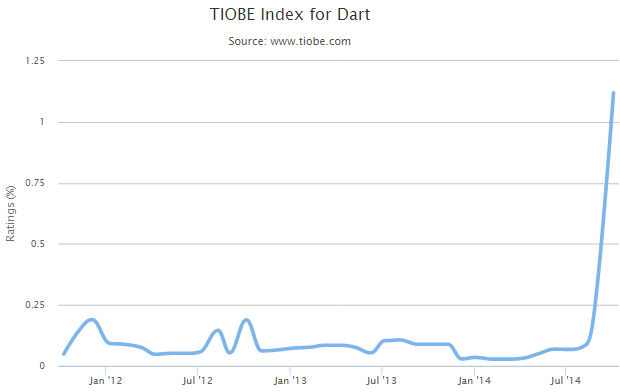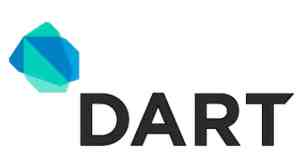| The Astonishing Rise Of Dart |
| Written by Mike James | |||
| Monday, 13 October 2014 | |||
|
If the signs are to be believed Dart, Google's JavaScript replacement is shooting up the popularity stakes. Should Dart be the next language you learn? Dart is a fairly boring language. It is a single-inheritance, object-oriented language in the style of Java, C# etc, but with optional typing and first class functions. Some aspects of the language make compiling it to JavaScript easier.
How to run Dart is the language's biggest question. You can compile it to JavaScript, but this puts it in the same category as languages such as CoffeeScript that do the same thing. There is also the issue of what browsers the dart2js compiler supports - no IE before version 9 and only the latest Chrome and Firefox. If you want to run it natively in a browser your only choice is Chrome and even then you can't use a standard edition. Rather you need the Dartium version that comes with the Dart code editor. It has been generally thought that for Dart to be adopted it would have to be approved by the other big browser makers, and so far this has looked very unlikely. Indeed Microsoft, Apple and elements of Mozilla have criticised Dart for diluting the efforts being made to improve JavaScript. There has also been a lot of suspicion about Google's motives in creating an alternative to the web's de facto standard language. On the plus side, Dart has made some recent steps toward looking more attractive. In July of this year ECMA issued a standard for the language, which is reassuring in that Dart isn't just Google's language any longer. The dart2js compiler was initially judged as slow but the latest version creates code that runs faster than handcrafted JavaScript. Finally, in June, the Chrome Dev Editor made it much easier to get started writing Dart apps. Suddenly Dart looked like a good candidate for web apps and Chrome apps. It is difficult to say whether any of these developments is the cause of the astonishing change in this month's Dart TIOBE index. After showing only small pulses of interest since its introduction in late 2011, Dart has suddenly entered the top 20 languages at number 17 after a rapid and sustained spike starting at the end of July 2014. To give you some idea of where this places the language, its TIOBE ranking is better than F# and close to Ruby. From nothing much to being as popular as Ruby means you probably need to take notice of Dart in the future. Take a look at the way the index has changed:
Of course there are all of the usual caveats about the TIOBE index, but no matter what you think is being measured, something clearly happened at the end of July. It is so unusual that the thought that someone might be gaming the TIOBE index does occur. As an interesting coda, it is also worth mentioning that a suggestion on the UserVoice forum to the Microsoft IE team is that a Dart VM be added to Internet Explorer. Although this suggestion has only been up for a week it already has over 1500 supporting votes together with lots of negative comments. A similar suggestion that the team should support ASM.js has fewer votes. Given Microsoft's tendency to ignore any such proposal that doesn't fit in with its prevailing opinion, this doesn't mean anything much will happen. I don't think that it's time to learn Dart or to take it any more seriously, but it is time to start to monitor its progress more carefully. |
VS Code 1.98 Increases AI Assistance 17/03/2025 The latest update of Visual Studio Code is now available with the main improvements related to its use of GitHub Copilot. The update also adds a preview of Intellisense completion in the terminal. |
Gemini Code Assist Adds Free Layer 10/03/2025 Google has announced the public preview of Gemini Code Assist for individuals, a free version of Google's AI-coding assistant together with Gemini Code Assist for GitHub, which provides free, AI- [ ... ] |
More News
|
Comments
or email your comment to: comments@i-programmer.info




